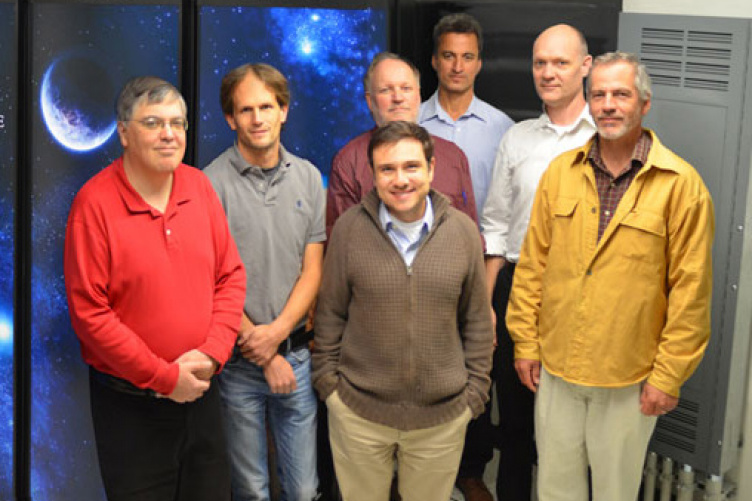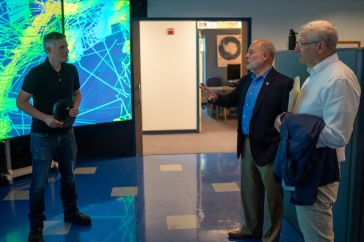
From left to right, Bernie Vasquez, Kai Germaschewski, Gregory Chini (front), Jimmy Raeder, Benjamin Chandran, John Gibson, and Patrick Messer. Photo by Kristi Donahue, UNH-EOS.
There’s a new supercomputer in town and it’s making leading-edge research in multiple facets of modern physics possible at the University of New Hampshire’s Institute for the Study of Earth, Oceans, and Space. The Cray supercomputer, the only one in New Hampshire, was made possible by a $534,977 Major Research Instrumentation (MRI) award from the National Science Foundation, including $196,995 from NSF’s Experimental Program to Stimulate Competitive Research, or EPSCoR.
The new supercomputer, dubbed Trillian after a character in the comic science fiction series “The Hitchhiker’s Guide to the Galaxy,” is roughly 1,000 times more powerful than a typical desktop computer. It replaces an older cluster, Zaphod, which is now retired after eight years of operation. While Zaphod has enabled numerous studies and some breakthroughs in computational physics, the new system will be at least 15 times faster and more powerful and will advance the science even further.
“With Trillian, we can do bigger, more accurate simulations faster,” says Space Science Center (SSC) astrophysicist Joachim “Jimmy” Raeder, lead UNH scientist on the MRI grant. “And one basic advantage of having a supercomputer here is the quick turnaround—we don’t have to buy time on a remote supercomputer or move data, we can store it locally and efficiently.” Raeder also notes that the computer will allow graduate students and post-doctoral researchers to get hands-on experience. “It’s their machine, and they’ll be allowed to do much more on it than they would logging onto a machine remotely.”
Raeder, colleagues from the SSC/physics department, and scientists from the UNH mechanical engineering department and the department of mathematics and statistics will use the powerful Cray system to study the solar wind and its properties, turbulence in fluids and plasmas (hot gases composed of charged particles), magnetic reconnection (a process in which magnetic fields reconfigure themselves and release enormous amounts of energy) in the sun’s atmosphere and Earth’s magnetosphere, and space weather, which results from the solar wind blowing on the magnetosphere and causing northern lights and geomagnetic storms.
Besides being an essential research tool for Raeder, six UNH co-investigators and their affiliated researchers, post-doctorate associates, and students, Trillian will also play a role in computational science classes and is open to other researchers on campus who need serious computing power.
Several companies bid on the chance to provide that much computing power to the UNH campus. Notes Raeder, “Out of the competitors who bid on this project, Cray emerged as being capable of providing the best solution for what we were looking for.”
“We are honored that the University of New Hampshire selected Cray to provide its researchers and scientists with the computational resources of a Cray supercomputer,” says Tony Gelsomini, senior account manager at Cray. “Personally, as a long-time resident of New Hampshire, I am proud that Cray and UNH were able to work closely together to make the Trillian project a reality for present and future research at the university.”
The installation of the Cray system takes advantage of the recent modernization and expansion of the Research Computing and Instrumentation machine room, which provides the stable infrastructure and efficient power supply and cooling. The improvements also minimize the carbon footprint of the machine room.
“This is just the type of activity we were targeting with the recent renovations to the data center,” says RCI director Patrick Messer. “It’s exciting to see everything come together so well.”
Additional UNH funding for the cluster came from the SSC, the Office of the Senior Vice Provost for Research, the College of Engineering and Physical Sciences dean’s office, and the RCI.
“This cutting-edge supercomputer will allow us to conduct nationally and internationally relevant, high-impact research at a much faster pace,” says Jan Nisbet, senior vice provost for research at UNH.
-
Written By:
Staff writer | Communications and Public Affairs
















































